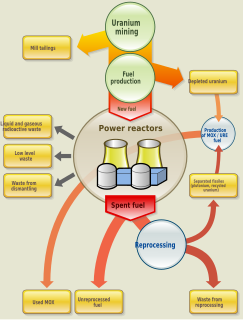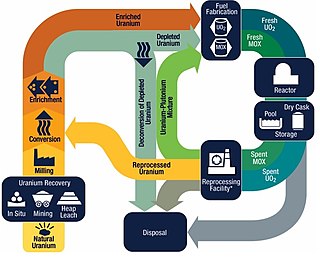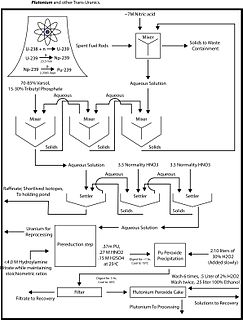 W
WThe bismuth-phosphate process was used to extract plutonium from irradiated uranium taken from nuclear reactors. It was developed during World War II by Stanley G. Thompson, a chemist working for the Manhattan Project at the University of California, Berkeley. This process was used to produce plutonium at the Hanford Site. Plutonium was used in the atomic bomb that was used in the atomic bombing of Nagasaki in August 1945. The process was superseded in the 1950s by the REDOX and PUREX processes.
 W
WThe Clab, also known as Centralt mellanlager för använt kärnbränsle is an interim radioactive waste repository located about 25 kilometers north of Oskarshamn Nuclear Power Plant and is owned by Oskarshamnsverkets Kraftgrupp AB (OKG), in Oskarshamn. It was opened in 1985 for the storage of spent nuclear fuel from all Swedish nuclear power plants. The fuel is stored for 30 to 40 years, in preparation for final storage.
 W
WNovouralsk is a closed town in Sverdlovsk Oblast, Russia, located on the eastern side of the Ural Mountains, about 70 kilometers (43 mi) north of Yekaterinburg, the administrative center of the oblast. Population: 85,522 (2010 Census); 95,414 (2002 Census).
 W
WNuclear fuel is material used in nuclear power stations to produce heat to power turbines. Heat is created when nuclear fuel undergoes nuclear fission.
 W
WThe nuclear fuel cycle, also called nuclear fuel chain, is the progression of nuclear fuel through a series of differing stages. It consists of steps in the front end, which are the preparation of the fuel, steps in the service period in which the fuel is used during reactor operation, and steps in the back end, which are necessary to safely manage, contain, and either reprocess or dispose of spent nuclear fuel. If spent fuel is not reprocessed, the fuel cycle is referred to as an open fuel cycle ; if the spent fuel is reprocessed, it is referred to as a closed fuel cycle.
 W
WPUREX is a chemical method used to purify fuel for nuclear reactors or nuclear weapons. PUREX is the de facto standard aqueous nuclear reprocessing method for the recovery of uranium and plutonium from used nuclear fuel. It is based on liquid–liquid extraction ion-exchange.
 W
WSpent nuclear fuel, occasionally called used nuclear fuel, is nuclear fuel that has been irradiated in a nuclear reactor. It is no longer useful in sustaining a nuclear reaction in an ordinary thermal reactor and depending on its point along the nuclear fuel cycle, it may have considerably different isotopic constituents.
 W
WThe thorium fuel cycle is a nuclear fuel cycle that uses an isotope of thorium, 232Th, as the fertile material. In the reactor, 232Th is transmuted into the fissile artificial uranium isotope 233U which is the nuclear fuel. Unlike natural uranium, natural thorium contains only trace amounts of fissile material, which are insufficient to initiate a nuclear chain reaction. Additional fissile material or another neutron source is necessary to initiate the fuel cycle. In a thorium-fuelled reactor, 232Th absorbs neutrons to produce 233U. This parallels the process in uranium breeder reactors whereby fertile 238U absorbs neutrons to form fissile 239Pu. Depending on the design of the reactor and fuel cycle, the generated 233U either fissions in situ or is chemically separated from the used nuclear fuel and formed into new nuclear fuel.
 W
WThe Wackersdorf nuclear reprocessing plant is a reprocessing plant in Wackersdorf in Bavaria, Germany. Because of protests the plant was never completed. Today it is an industrial site with no special features.